Wetsuit technology is a constantly evolving field in the surf industry, one that can be hard to keep up on.
We created this guide to educate both new and seasoned surfer's on the newest wetsuit technology available on the market today. Use it as a guide to buy a new wetsuit, or simply to brush up on your wetsuit knowledge.
Keep in mind this is just simple guide. If you would like dive in further rap with one our coldwater specialists - please feel free to give us a shout!
Lets start by taking a look at what wetsuits are made out of.
WHAT ARE WETSUITS MADE OUT OF?
The lifeline of most wetsuits is neoprene.
Discovered by Jack O’Neill in the 1950s as useful material for surfing, neoprene is an extremely stretchy rubber made from melted-down petroleum chips that are blown into a mold that ends up 3 - 4 inches thick. This is then cut down to size and fitted with a jersey lining. The jersey is a material that holds the neoprene together - typically made out of nylon.
Neoprene is NOT meant to keep you dry!
It is made up of closed cell foam that provide insulation against cold water by trapping a thin layer of water between you and your suit - preventing you from losing too much heat while in the water. Your body heat warms up the thin layer of water between you and the suit, insulating you from the cold water. The thicker the neoprene, the warmer the suit will be.
DIFFERENT TYPES OF NEOPRENE
There's a lot of different ways to build neoprene into a wetsuit - and these different types pay a huge role in the overall performace of a wetsuit. The best neoprene is lightweight, stretchy, durable, hydrophobic (or not too water absorbent) and insulating. By using these different types of neoprene, wetsuit manufactures are able to fine tune their suits to optimize performance and warmth.
NYLON LINED NEOPRENE
Traditional wetsuits are almost always lined with a nylon jersey. The nylon does a number of things to benefit the neoprene - such as providing a smooth surface over the neoprene for sliding on and off as well as protecting the neoprene from drying out from too much sun, cracking, splitting, and general wear and tear.
SMOOTH SKIN
Smooth skin neoprene has a smooth rubbery finish to it that is crucial for surfing in a cold environment. The smooth skin is great at repelling water and more importantly, the wind. For that reason you will typically see smooth skin covering the core region of the wetsuit to prevent the wind from cutting through and making the surfer cold. The downfall is that smooth skin is a not quite as durable as nylon line neoprene, and is much more susceptible to tears and rips.
AIR FILLED NEOPRENE
This type of neoprene has small pockets or void built in that hold air and help to insulate the surfer - a similar concept as double paned windows in a house. This construction allows the wetsuit manufacture to build a very warm suit without having to increase the thickness (and therefore the weight) of the wetsuit. This is used in premium wetsuits only.
WHAT ARE WETSUITS MADE OUT OF?
FIT
WARMTH
FLEXIBILITY
DURABILITY
As we work through wetsuit construction and features, we will mention each of these 4 crucial elements of the wetsuit and explain how they are affected by design.
THE RIGHT TOOL FOR THE JOB
Whether your surfing in Chacama in Peru or Monahan's Dock in Rhode Island, having the proper wetsuit for the water temperature ensures that you are comfortable in the water and get the most out of your session. Since we are based in Rhode Island, we will begin by checking out seasonal water temperature fluctuations for Narragansett.
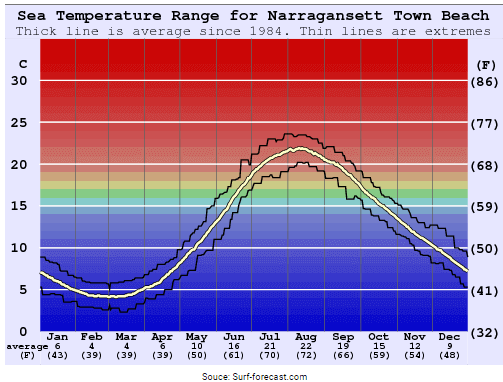
Unfortunately, the water temperature here in New England, and the Rhode Island weather in general, varies a great deal over the course of the year. The chart above shows the fluctuation in water temperature at Narragansett Town Beach, getting coldest through February and March - reaching as low as 36 degrees Fahrenheit! On the other end of the spectrum, water temperature can reach into the mid-70s in July and August. Having such a dramatic temperature gradient can make it difficult to choose the proper wetsuit for New England - with such a variety of wetsuits with varying thicknesses, seam qualities, and other attributes.
WETSUIT THICKNESS
Wetsuit thickness is one of the most important aspects when considering a wetsuit, it is the biggest warmth factor of the suit. Wetsuit thickness is measured in millimeters, typically written with two or three numbers separated by a line. The first number refers to the thickness of neoprene in the torso/core region, while the second number refers to the thickness of the neoprene in your extremities. If there is a third number, it refers to the thickness in the arms only.
Wetsuits are set up this way to maximize both warmth in your core and flexibility in your extremities. The following should help you decide what thickness suit you should be looking for to surf anywhere in the world, with consideration on water temperature:

The recommendations listed above are only general suggestions - as everyone has a different tolerance to cold water. It is also important to consider air temperature and wind speed rather than water temperature alone when choosing the right wetsuit.
To identify the thickness of a particular wetsuit, you can look at the left sleeve towards the wrist cuff. There will usually be an indicator of the thickness written on the outside of the wetsuit.

TYPES OF WETSUITS

NEOPRENE JACKET
A neoprene jacket is thin neoprene top that is perfect for the summer time in Rhode Island to keep the cold off your back when you do not need a full wetsuit. They are also great for traveling to surf, as they do a great job at preventing rash from extended periods of surfing. neoprene jacket thickness ranges from 0.5mm to 2mm.
SPRING SUIT / SHORT
Another great summertime wetsuit for New England the shorty is a is a wetsuit that features short sleeves and short legs. Essentially the shorty heats your core but allows full mobility in your extremities. Shorty wetsuits typically come in 2mm thickness.
SHORT SLEEVE FULL
One of the most comfortable wetsuits on the market (in my opinion) is the short sleeve full. These wetsuits are similar to the shorty, though they have full legs instead of shorts. Great for early summer or fall in New England. Short Sleeve full wetsuits typically come in 2mm thickness.
3/2 FULL
One of the most common wetsuit thicknesses is the 3/2. Used in surf schools all over the world - chances are this is what you were wearing when you caught your first wave! The 3/2 is full suit featuring 3mm in the chest and back and 2mm in the extremities. In New England we typically wear these suits in the late spring/early summer and into the Fall.
4/3 FULL
A bit thicker than the 3/2, the 4/3 wetsuit is a warmer option and a must have for all surfers in the North East. The 4/3 wetsuit features 4mm neoprene in the core and back with 3mm through the extremities. Surfers in NE typically wear these suits in the Spring and through the Fall and early Winter.
WINTER WETSUIT
The winter suit is crucial for New England surfers to be able to surf through the year. Winter wetsuits come in a variety of thickness (typically 5/4 or thicker), and almost always have a built in hood. Winter wetties are usually built with welded or taped seams to prevent water from seeping into the suit. A must have wetsuit for New Englanders that surf between December and May.
WETSUIT FIT AND SIZING
The most important factor when it comes to buying a new wetsuit is FIT. In order to create the ultra thin layer of water between you and your suit - the suit should fit like a second skin.
If it is your first time trying on a wetsuit, don’t be surprised if it feels too tight. That doesn't mean that it should be cutting off your circulation/breathing or anything along those lines - but the tighter the better. Remember - It will loosen up when it hits the water.
If the suit is too big it will bunch up in certain areas which can cause rash and irritation when your out there surfing. It can also lead to an increase in wetsuit "flushing" - which is when water between you and the wetsuit rushes out and is replaced with cold water.
Check out our wetsuit sizing guide below to see how you match up. The sizing charts are just a guide to finding the right size, but should be taken with lightly. Everyone has a different body type, and even though your height and weight match up with a certain size - there's a chance that it will still not be the right fit. If this happens to you and you find your self between sizes, it may be worth trying a different brand as they all fit a bit differently.
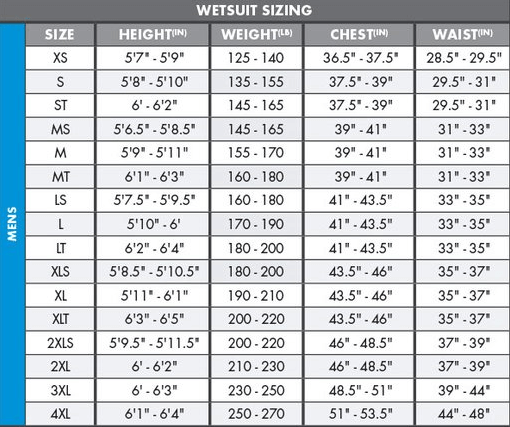
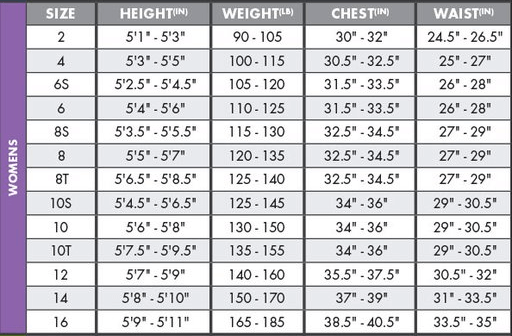
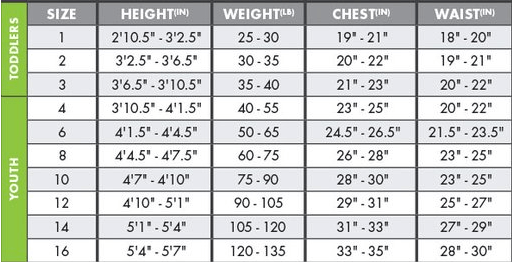
NOTE: If you are looking at kids’ wetsuits for your child and they are at an age where they are going through a different size every month, it is okay to buy a suit that is slightly big. This will give them some time to grow into and it, and of course spare you the frustration of having to buy a new suit for them every other month!
TYPES OF WETSUIT SEAMS
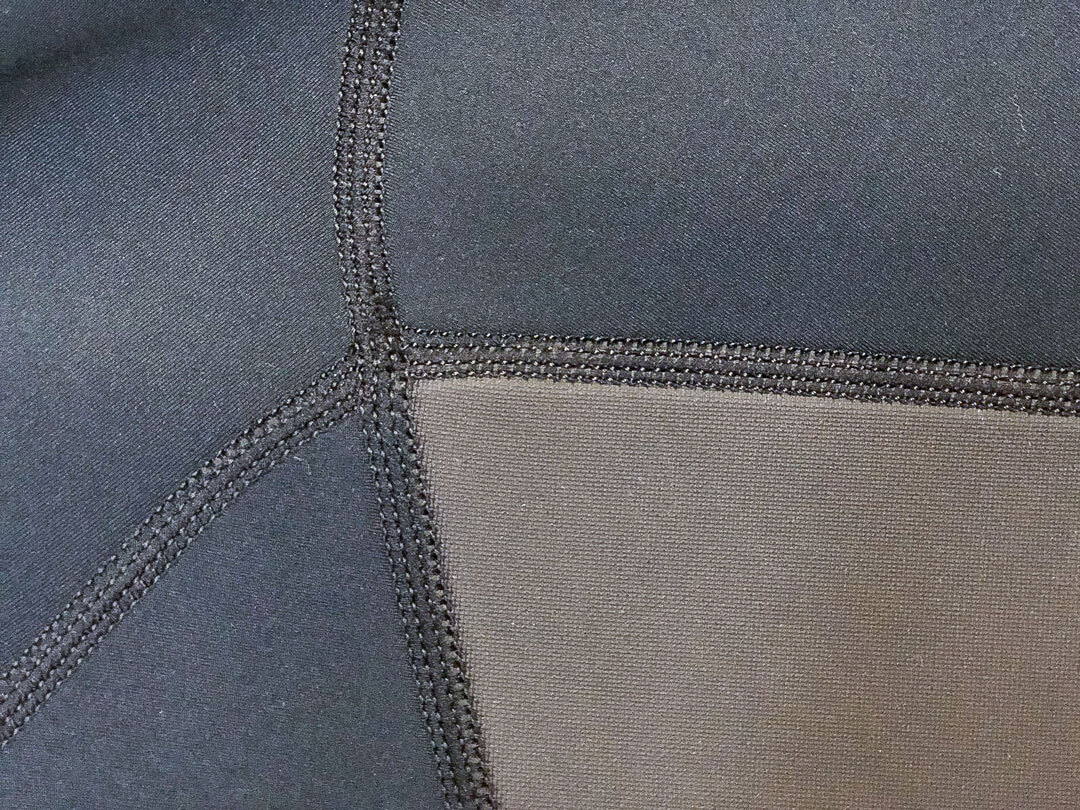
FLAT LOCK STITCH
This type of stitching involves laying one panel edge over the other and stitching through the neoprene - resulting in a flexible and strong seam. The downfall of this type of stitching is that water can penetrate through the seam. For this reason, flatlock stitching is usually only found in suits that are meant for warmer water (ie. spring suits and some 3/2’s).
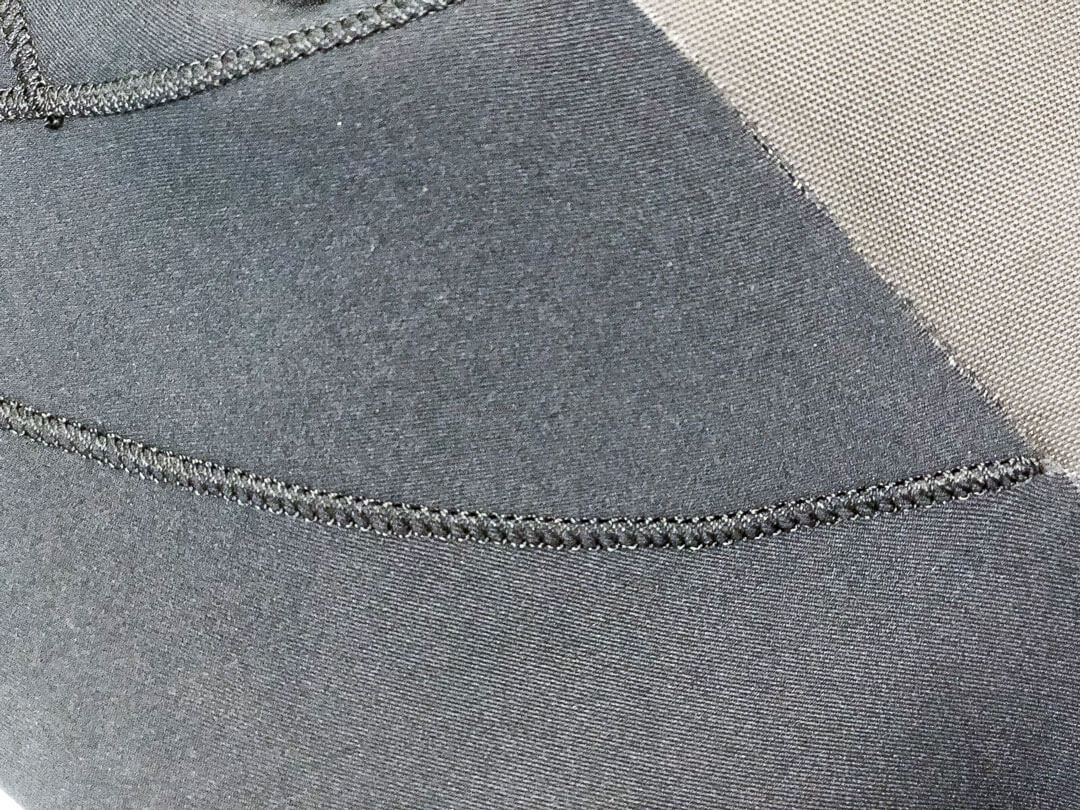
GLUED & BLIND STITCH
This type of stitching involves laying the panels end to end and gluing them together. The panels are then stitched together, but the stitching does not go all the way through the neoprene. The result is a water tight and flexible seam - making it ideal for colder water. Although these seams are typically found on the more expensive/higher quality suits, it is worth spending extra for this type of suit if you plan to surf into the fall/winter.
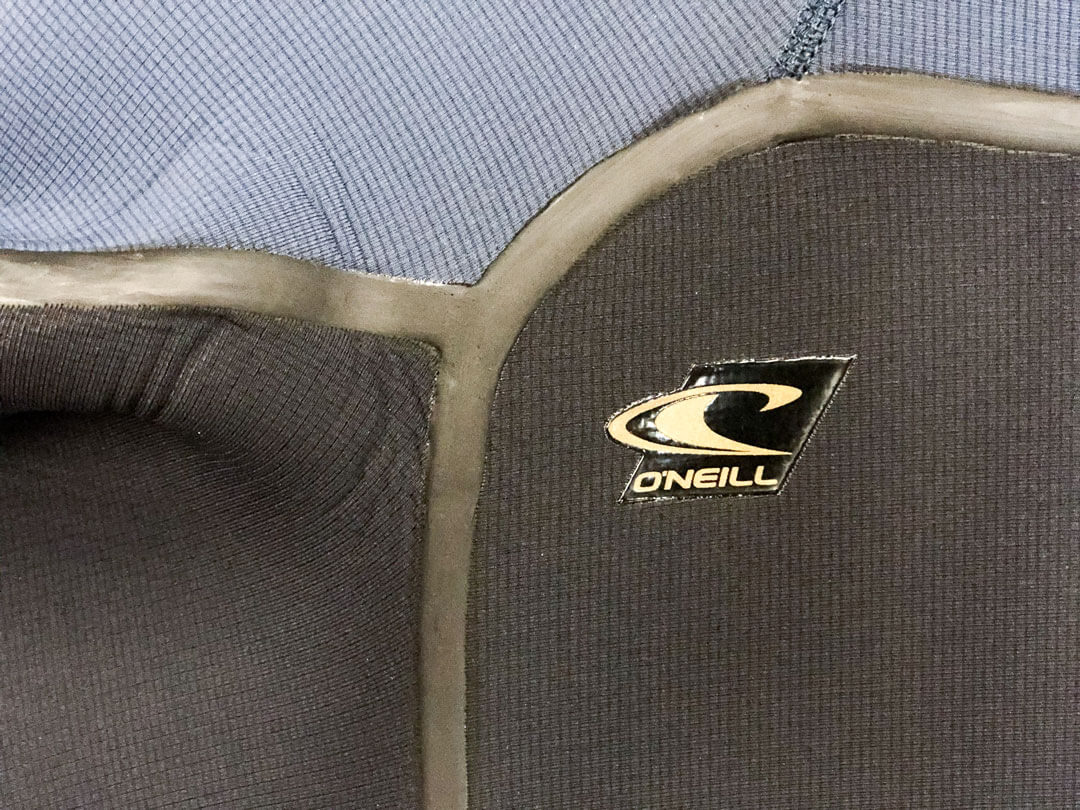
WELDED
This type of seam may also be called fluid seams or liquid taping. This type of seam is sealed on the outside of the suit using melted/liquid neoprene. This ensures that the seam is not only durable, but also is impenetrable by water. This type of seam is ideal for cold-water wetsuits - and are usually only found in the more premium wetsuit options.
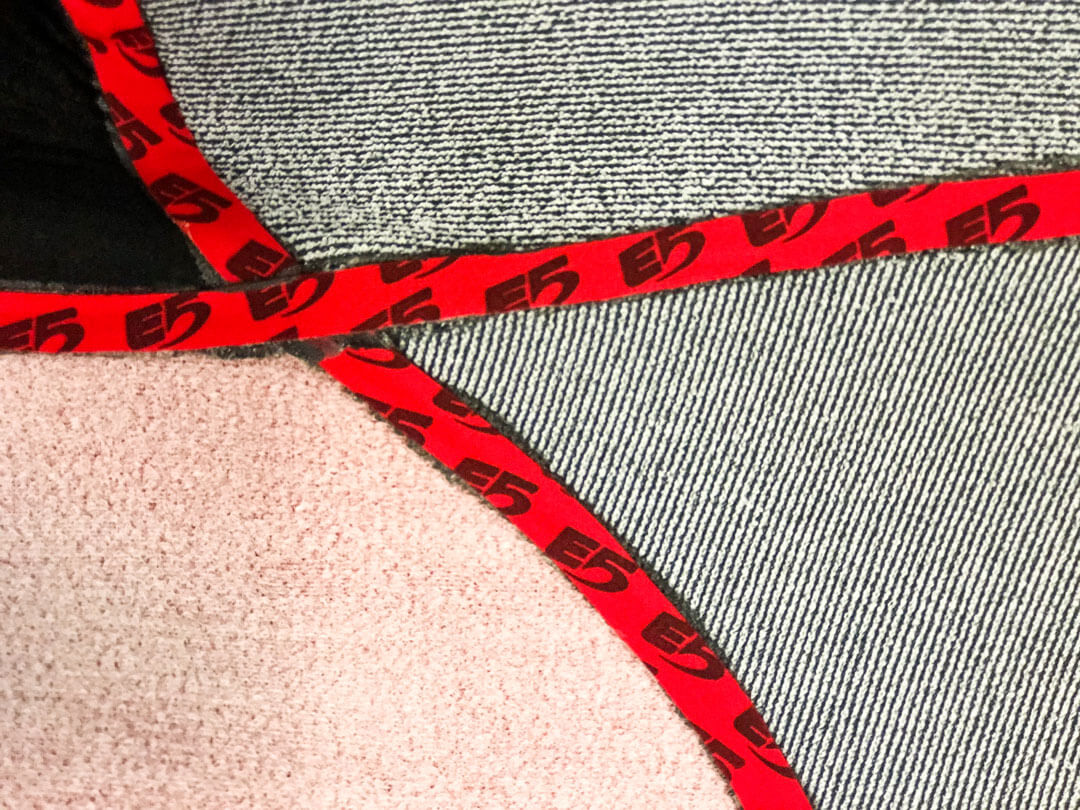
TAPED
This type of seam is similar to the welded seams, but instead they are sealed on the inside of the suit using a flexible "tape". This option is a bit lighter weight than the welded seams, and may also be a bit more flexible. It is sometimes coupled with outside seam welding in more premium suits, but most of the time it is coupled with GBS seam. This is ideal for cold-water wetsuits - and are usually only found in the more premium wetsuit options.
Some suits may be fully taped through the inside, or only along crucial areas such as the lower body or along seam intersections.
CHOOSING THE RIGHT SEAM
Many suits on the market today will use some combination of the above types of seams - and it's up to you to decide what is most important for you and the area that you are surfing. For example if you are looking for a 3/2 wetsuit for the summer in Rhode Island, you may opt for a suit that has taping only along the crucial areas, and GBS in the arms. In the summer, you aren't as concerned with warmth, so this suit would give you increased flexibility while also feeling lighter weight.
On the other hand, if you are looking for a suit that will get you through a brutally cold winter in the North East, than you will want a suit that has either taped and welded seams that will not let water flow freely through it to ensure that you are keeping as warm as possible.
WETSUIT ENTRY SYSTEMS
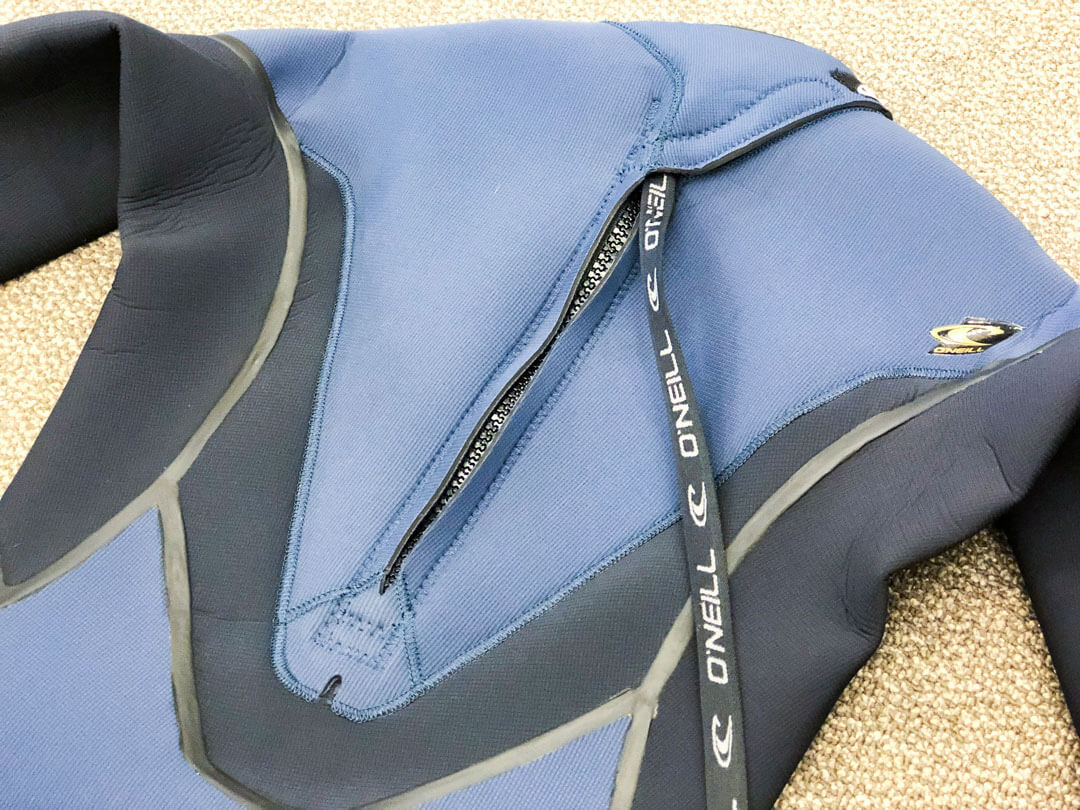
BACK ZIP
This is the classic entry system found on wetsuits, featuring a long zipper going down the length of the spine with a long cord attached to the zipper to get yourself in and out. This is for sure the easiest wetsuit to get in and out of. The downfall of having back zip wetsuits is the probability of water flushing through the back of the suit or loose collar while duck diving a wave or wiping out. Another important thing to keep in mind is that zippers don't stretch, so by placing a zip across the back you create a big stretchless zone between your shoulders.
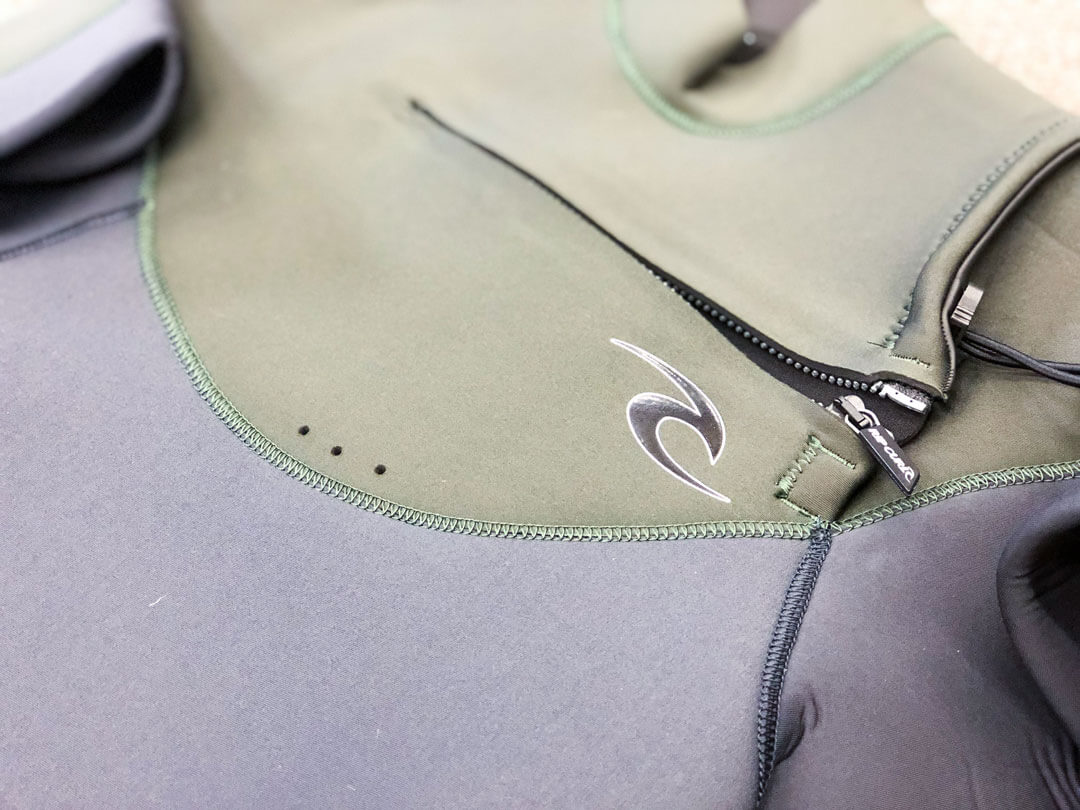
CHEST ZIP
A great alternative to the back zip suit is a chest zip wetsuit, in which the you enter the suit through a zippered cutout around the neck. These suits are a bit trickier to get on, but offer more flexibility, especially in the shoulders and back. The chest zip is also much more effective at keeping water from flushing the suit than a traditional back zip.
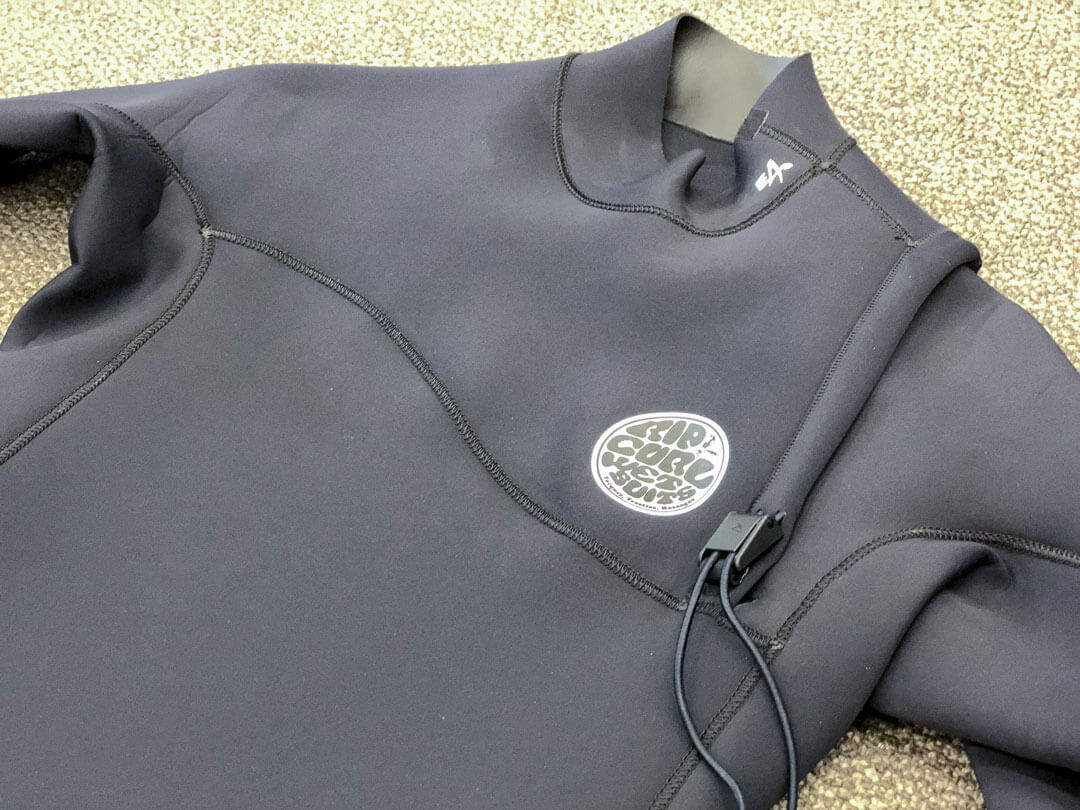
ZIP FREE
Some wetsuits are also offered in zip free configurations. These are a usually similar in appearance to a chest zip suit, except that there is no zipper. This is the hardest suit to get in and out of, however the flex and comfort is worth the struggle. To get into the suit, you need to fold over the neck panel and climb through the cutout area in the neck.

WETSUIT BOOTS
Neoprene boots are an essential part of surfing in cold water, and some folks use them in warmer water to protect their feet from getting cut up on rocks or reef. Similar to wetsuits, boots should fit as tight as possible without causing discomfort. This prevents them from filling with water, as well as keeps them from folding over when attempting to pop up.
WETSUIT GLOVES
Neoprene gloves are a great way to keep your hands from getting numb in coldwater, a common occurrence for fall/winter surfing. Gloves should fit nice and tight, preventing water from filling and the fingers from folding over. The three main types of gloves are 5-finger, 3-finger (aka lobster claws), and mittens.
WETSUIT HOODS
Neoprene hoods are ideal in cold water to prevent the awful “ice cream headache” or brain freeze that occurs when duck diving under cold waves. Again, making sure the hood fits tight is key, as a baggy hood will fill with water and freeze your head, and it is also a good idea to keep cold water out of your ears.
WETSUIT CARE
One question that we get asked by almost every customer of ours is how to care for their wetsuit to get the most life out of it? When you purchase a wetsuit you should know that it is not going to last you forever. However, following a few simple guidelines could be the difference in your suit lasting 2 years or 5 years.
BE GENTLE
When putting your wetsuit on and taking it off you should pay extra attention to being gentle. Most of the time that we see suits come back with a tear in it - it is almost always due to the user taking the wetsuit off. Yanking on your suit to hard will put stress on the neoprene and could cause a tear if pulled too hard (especially if you haven't cut your fingernails in a while). It helps to use a plastic bag on your feet and hands when sliding the suit on. Also important to slowly zip the wetsuit, and do not force it. Breaking a zipper can sometimes mean the end of your wetsuit.
RINSE YOUR SUIT
After every use in the ocean you should be rinsing your wetsuit thoroughly with freshwater. Salt will destroy your wetsuit faster than anything else (besides prolonged time in direct sunlight).Take time to rinse your suit every single time, inside and out. Let your suit hang while it drips dry.
ALWAYS HANG YOUR WETSUIT
This is very important! Always keep your wetsuit hung properly, keeping it out of direct sunlight. Don’t throw it over the railing, your car mirror, or hang it on hook for too long - as this may cause the suit to stretch out in an unfavorable way. Take a wide plastic hanger and hang the suit up in the shade to dry out. If you bought the wetsuit from us - chances are we gave you a proper hanger with it. Turn the suit inside out occasionally until it is fully dry.
Note: Never use a metal wire hanger or thin plastic hanger on your wetsuit. This will stretch out the neoprene in the shoulders to the point of no return.
CLEAN YOUR WETSUIT
If your suit starts to stink to the point that your friends stop wanting to surf with you, consider purchasing some wetsuit shampoo. No matter how thoroughly you rinse your suit, you’re bound to miss some spots - and the shampoo will for sure get the stink out.Trust us - no one wants to surf with the smelly person!
WETSUIT REPAIR
If you forget one of the above principles and end up with a tear or hole in your wetsuit - try not to freak out! Wetsuits are fairly easy to repair as long as you catch it early before the damage spreads. You can purchase neoprene cement or aqua seal at our retail location - and we will give you a few patches on the house if you need. Feel free to bring the wetsuit with you to the shop and we can give yuo a step by step instruction on how you can fix the wetsuit yourself! Stay tuned to our blog for a wetsuit repair how-to coming soon.
WETSUITS BRANDS THAT WE CARRY

O'NEILL
The Original wetsuit manufactures in the surf industry - founded by Jack O'Neill in 1952 in California. Jack O'Neill is often credit as being a pioneer of the surfing wetsuit - and O'Neill keeps that momentum going as being one of the leaders in innovative wetsuit technology in the surf industry. Their new Technobutter neoprene may be the stretchiest rubber we've ever worn!

RIP CURL
A globally renowned leader in wetsuit technology out of Australia - Rip Curl continues to push the limits with their exceptional wetsuits with insane comfort and durability in their wetsuits. The coolest part? Rip Curl is one of the last remaining surf companies that is still owned by it's founders - who happen to be ripping surfers!

XCEL
World class wetsuits founded in the state of Hawaii - Xcel does it all. They have an incredible team of athletes that continue to push the limits in the surf as well as freediving. One of our favorite things about Xcel? They make one of the best winter wetsuits on the market that are great for the New England area. They're suits are some of the most rugged and durable wetsuits on the market!